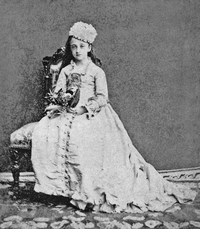Nazime Sultan
| Nazime Sultan | |
|---|---|
 | |
| Born | 25 February 1867 Dolmabahçe Palace,Constantinople,Ottoman Empire (nowIstanbul,Turkey) |
| Died | 9 November 1947(aged 80) Jounieh,Lebanon |
| Burial | |
| Spouse |
Ali Halid Pasha
(m.1889–1947) |
| Dynasty | Ottoman |
| Father | Abdulaziz |
| Mother | Hayranidil Kadın |
| Religion | Sunni Islam |
Nazime Sultan(Ottoman Turkish:ناظمه سلطان;"clouds"or"poetic";25 February 1867 – 9 November 1947) was an Ottoman princess, the daughter of Ottoman SultanAbdulazizandHayranidil Kadın.
Early life
[edit]Nazime Sultan was born on 25 February 1867[1]in at theDolmabahçe Palace.[2]Her father was SultanAbdulaziz,and her mother wasHayranidil Kadın.She was the second daughter of her father and the first child of her mother. She was the elder full sister of the future CaliphAbdulmejid II.[3][4]She was the granddaughter ofMahmud IIandPertevniyal Sultan.[5]
Her father, Abdulaziz was deposed by his ministers on 30 May 1876, his nephewMurad Vbecame the Sultan.[6]He was transferred toFeriye Palacethe next day.[7]Her mother, and other women of Abdulaziz's entourage didn't want to leave the Dolmabahçe Palace. So they were grabbed by hand and were sent out to the Feriye Palace. In the process, they were searched from head to toe and everything of value was taken from them.[8]On 4 June 1876,[9]Abdulaziz died under mysterious circumstances.[10]
Nazime Sultan, a ten-year-old girl, continued to live in the Feriye Palace with her mother and eight-year-old brother.[11]Recounting the event in an interview to Adil Sulh Bey years later, Nazime said:[12]
Any claims that my father committed suicide are deceitful. I saw it with my own eyes that they murdered my father.[13]
Marriage
[edit]In 1889 Sultan Abdul Hamid II arranged her trousseaux and marriage together with her two sisters, princessesSaliha SultanandEsma Sultan,as well his own daughterZekiye Sultan.[14]She married Ali Halid Pasha, the son of Ibrahim Derviş Pasha on 20 April 1889 in theYıldız Palace.[4][3][5]
The couple were given a palace located at Kuruçeşme, known as Nazime Sultan Palace, as their residence.[15]Here she had performers of religious music.[16]She did not have any children.
Philanthropy
[edit]Müdafaa-i Milliye Hanımlar Cemiyeti (Woman's Chapter of the Society of National Defense), an organization was established in September 1912 and went to Istanbul to take care of people wounded in theBalkan Wars.Upon its establishment in February 1913, the Women's Chapter of the Society of National Defense organized two meetings at the Darülfünun Lecture Hall under the auspices of Nazime and Nimet Mukhtar, daughter of KhediveIsma'il Pasha,which were led by Selma Hanım, sister of Ahmed Rıza Bey, a prominent CUP member and the head of the parliament.[17]
In 1912, the "Hilal-i Ahmer Centre for Women" was organized within the "Ottoman Hilal-i Ahmer Association", a foundation established in 1877 to provide medical care in Istanbul and surrounding communities.[18]In May 1915, during theGallipoli Campaign,as the member of this organization, Nazime donated 50 Turkish liras to a hospital to purchase beds and other goods for soldiers.[19]
Exile
[edit]Following the imperial family was sent to exile in 1924, Nazime and her husband settled inJounieh,Lebanon.[5]Here the two lived in a large mansion surrounded by garden.[20]
WhenDürrüşehvar Sultanmarried PrinceAzam Jah,the eldest son and heir of the lastNizamofHyderabad State,Osman Ali Khan, Asif Jah VIIin 1932, Nazime Sultan gave her a diamond tiara. ToNeslişah Sultan,she offered a beautiful bracelet em Boss ed with three diamonds, when she married PrinceMohamed Abdel Moneim,son of Egypt's lastkhediveAbbas Hilmi IIin 1940.[20]
According to Neslişah Sultan, she was tiny, rather ugly, with large lips like her father's, but quite impressive.[20]
Death
[edit]
Nazime died on 9 November 1947 inJounieh,Lebanon.She was the last surviving child of Abdulaziz. She was buried in the cemetery of theSulaymaniyya Takiyya,Damascus,Syria.Her husband outlived by one year, and died in 1948 inMecca,Saudi Arabia.[5]
Honours
[edit]| Styles of Nazime Sultan | |
|---|---|
 | |
| Reference style | Her Imperial Highness |
| Spoken style | Your Imperial Highness |
Ancestry
[edit]| Ancestors of Nazime Sultan | ||||||||||||||||||||||||||||||||||||||||||||||||||||||||||||||||||||||||||||||||||||||||||||||||||||||||||||||||||||||||||||||||||||||||||||||||||||||||||||||||||||||||||||||||||||||||||||||||||||||||||||||||||||||||||||||||||||||
|---|---|---|---|---|---|---|---|---|---|---|---|---|---|---|---|---|---|---|---|---|---|---|---|---|---|---|---|---|---|---|---|---|---|---|---|---|---|---|---|---|---|---|---|---|---|---|---|---|---|---|---|---|---|---|---|---|---|---|---|---|---|---|---|---|---|---|---|---|---|---|---|---|---|---|---|---|---|---|---|---|---|---|---|---|---|---|---|---|---|---|---|---|---|---|---|---|---|---|---|---|---|---|---|---|---|---|---|---|---|---|---|---|---|---|---|---|---|---|---|---|---|---|---|---|---|---|---|---|---|---|---|---|---|---|---|---|---|---|---|---|---|---|---|---|---|---|---|---|---|---|---|---|---|---|---|---|---|---|---|---|---|---|---|---|---|---|---|---|---|---|---|---|---|---|---|---|---|---|---|---|---|---|---|---|---|---|---|---|---|---|---|---|---|---|---|---|---|---|---|---|---|---|---|---|---|---|---|---|---|---|---|---|---|---|---|---|---|---|---|---|---|---|---|---|---|---|---|---|---|---|
| ||||||||||||||||||||||||||||||||||||||||||||||||||||||||||||||||||||||||||||||||||||||||||||||||||||||||||||||||||||||||||||||||||||||||||||||||||||||||||||||||||||||||||||||||||||||||||||||||||||||||||||||||||||||||||||||||||||||
See also
[edit]References
[edit]- ^Uçan, Lâle (2019).Dolmabahçe Sarayı'nda Çocuk Olmak: Sultan Abdülaziz'in Şehzâdelerinin ve Sultanefendilerinin Çocukluk Yaşantılarından Kesitler.FSM İlmî Araştırmalar İnsan ve Toplum Bilimleri Dergisi. p. 232.
- ^Brookes 2010,p. 286.
- ^abUluçay 2011,p. 225.
- ^abSakaoğlu 2008,p. 645.
- ^abcdAdra, Jamil (2005).Genealogy of the Imperial Ottoman Family 2005.pp.16.
- ^Zürcher, Erik J. (October 15, 2004).Turkey: A Modern History, Revised Edition.I.B.Tauris. p. 73.ISBN978-1-850-43399-6.
- ^Shaw, Stanford J.; Shaw, Ezel Kural (1976).History of the Ottoman Empire and Modern Turkey: Volume 2, Reform, Revolution, and Republic: The Rise of Modern Turkey 1808-1975, Volume 11.Cambridge University Press. p.164.ISBN978-0-521-29166-8.
- ^Brookes 2010,p. 40.
- ^Davison, Roderic H. (December 8, 2015).Reform in the Ottoman Empire, 1856-1876.Princeton University Press. p. 341.ISBN978-1-400-87876-5.
- ^Brookes 2010,p. 43.
- ^Şerofoğlu, Ömer Faruk (2004).Abdülmecid Efendi, Ottoman prince and painter.YKY. p. 24.ISBN978-9-750-80883-8.
- ^Ömer Faruk Yılmaz (27 September 2011),"Abdülaziz Han'ın kızı: Babamın katledilişini gördüm",timeturk,retrieved22 October2020
- ^Harun Yahya, Adnan (2017).Mastermind: The truth of the British Deep State Revealed.Araştırma Publishing. p. 263.
- ^Brookes 2010,p. 159.
- ^Barillari, Diana (1 January 1996).Istanbul 1900: Art-nouveau Architecture and Interiors.Random House Incorporated. p. 88.ISBN978-0-847-81989-8.
- ^Fanny Davis (1986).The Ottoman Lady: A Social History from 1718 to 1918.Greenwood Publishing Group. p. 158.ISBN978-0-313-24811-5.
- ^Atamaz-Hazar, Serpil (2010).The Hands that Rock the Cradle will Rise: Women, Gender, and Revolution in Ottoman Turkey, 1908-1918.University of Arizona. pp. 94–95.
- ^Hacker, Barton; Vining, Margaret (17 August 2012).A Companion to Women's Military History.BRILL. p. 199.ISBN978-9-004-21217-6.
- ^Os, Nicolina Anna Norberta Maria van (31 October 2013).Feminism, Philanthropy and Patriotism: Female Associational Life in the Ottoman Empire.Leiden University Institute for Area Studies (LIAS), Faculty of Humanities, Leiden University. pp. 449–450.
- ^abcBardakçı, Murat (2017).Neslishah: The Last Ottoman Princess.Oxford University Press. p. 176.ISBN978-9-774-16837-6.
- ^abcYılmaz Öztuna (1978).Başlangıcından zamanımıza kadar büyük Türkiye tarihi: Türkiye'nin siyasî, medenî, kültür, teşkilât ve san'at tarihi.Ötüken Yayınevi. p. 165.
Sources
[edit]- Brookes, Douglas Scott (2010).The Concubine, the Princess, and the Teacher: Voices from the Ottoman Harem.University of Texas Press.ISBN978-0-292-78335-5.
- Sakaoğlu, Necdet (2008).Bu mülkün kadın sultanları: Vâlide sultanlar, hâtunlar, hasekiler, kadınefendiler, sultanefendiler.Oğlak Yayıncılık.ISBN978-9-753-29623-6.
- Uluçay, Mustafa Çağatay (2011).Padişahların kadınları ve kızları.Ankara: Ötüken.ISBN978-9-754-37840-5.

